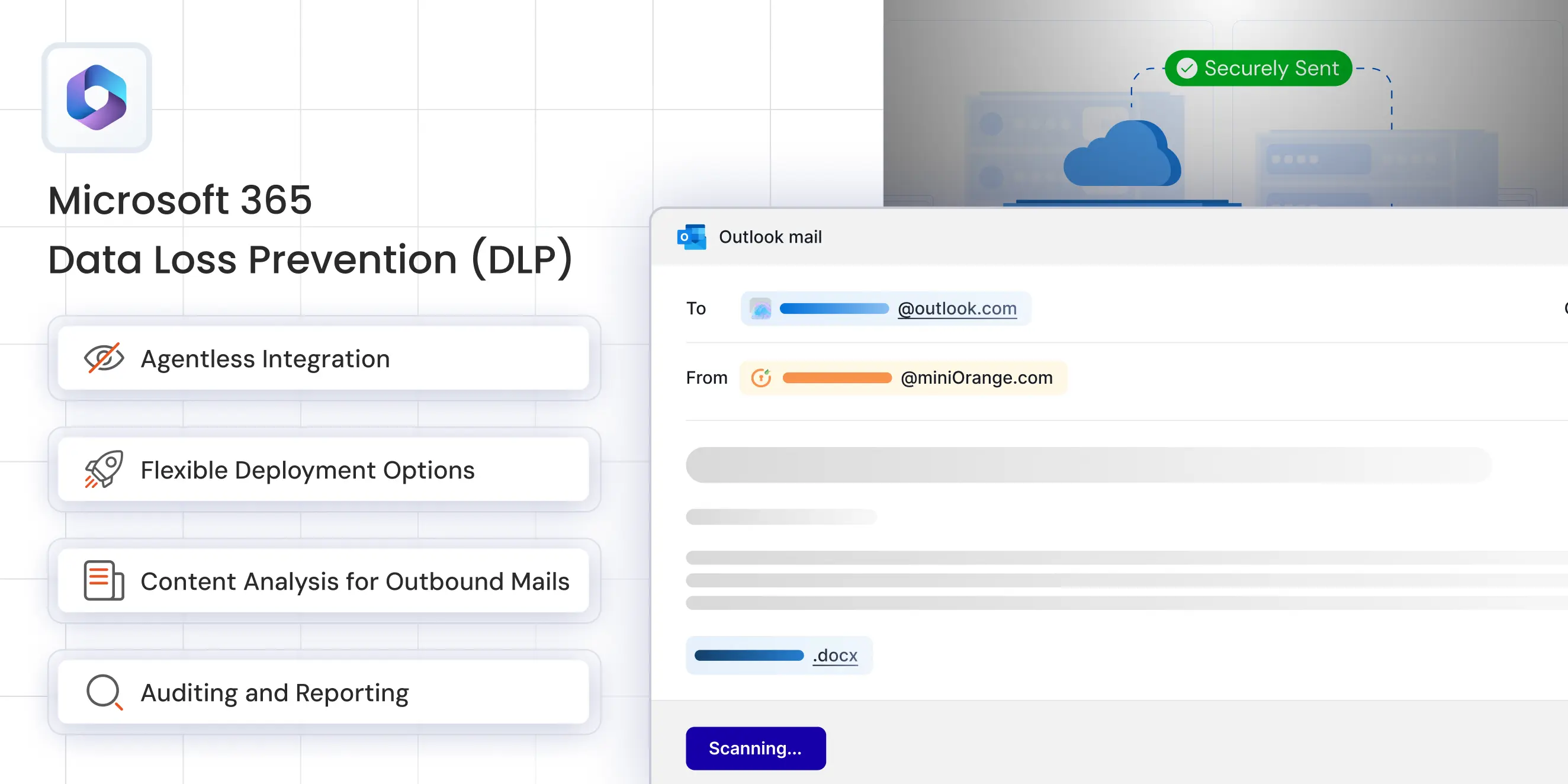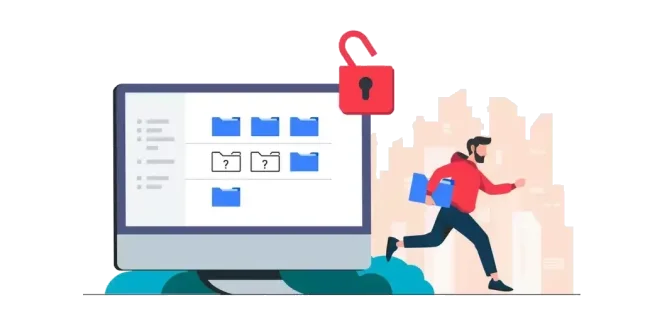Quick Intro?
Email is still the main way businesses communicate, with Microsoft Outlook alone serving over 400 million people worldwide. But it’s also one of the easiest ways to lose business information. A wrong email attachment, sharing of files to personal accounts, or misuse of a corporate email account by an employee can cause serious financial loss and damage to your company’s reputation.
Let’s find out how businesses can safely use Microsoft 365 Outlook with Email DLP for Outlook, monitor risks, and enforce security compliance policies actively.
What is Microsoft Office 365 DLP?
Microsoft 365 Data Loss Prevention (DLP) is a security tool designed to help businesses prevent unapproved data sharing and accidental data loss across Outlook, OneDrive, and SharePoint. While Microsoft provides its own DLP policies, in many cases, customers seem to face issues like security gaps, limited customization, and a lack of real-time alerts.
Due to these gaps, businesses are preferring third-party solutions like miniOrange Email DLP for:
- Stronger data protection
- Faster deployment
- Deeper customization
- Real-time data monitoring
- Detailed reporting
- Flexible rule configurations
Worried about sending the wrong file?
Use miniOrange Email DLP for Outlook to stop costly mistakes. Request a Free Demo
How Microsoft 365 DLP Works in Outlook?
Microsoft Office 365 DLP works by implementing security policies that specify what constitutes sensitive business data and what actions should be taken when such data is detected.
Here’s the step-by-step process when sending an email in Outlook:
- Identify Sensitive Information : DLP scans outgoing emails for predefined or custom patterns that match high-value data, such as financial statements, customer records, or proprietary designs, before the message is sent.
- Apply Policy Rules : Administrators set clear rules that determine what happens if sensitive data is detected. For example, blocking any attempt to send a confidential report to a personal email account or sharing project files with an unauthorized third party. These rules can be tailored based on data type, user role, or recipient.
- Monitor and Report : Security teams get real-time alerts and in-depth reports on policy violations, user activity, and potential risks. This visibility helps your business stay compliant, detect insider threats, and prevent costly breaches.
Pro tip: Want a faster, easier setup?
Follow this step-by-step guide for Email DLP for Outlook Setup Guide to configure advanced rules and compliance-ready policies in minutes.
Why Businesses Need Microsoft 365 Outlook DLP?
- Avoid Regulatory Penalties : Non-compliance with GDPR, HIPAA, and PCI-DSS can result in six-figure fines.
- Protect Brand Reputation : A single leaked email can damage years of client trust.
- Maintain Operational Security : Prevent confidential deal terms, R&D files, or legal documents from falling into the wrong hands.
Key Benefits of Microsoft 365 Data Loss Prevention for Businesses
- Prevent Costly Data Breaches : Microsoft Office 365 DLP blocks sensitive information such as financial data, client records, or intellectual property from leaving your organization through email or file sharing. This reduces the risk of legal fines and reputational damage.
- Centralized Policy Management : All DLP policies are managed from the Microsoft 365 DLP solution dashboard, ensuring consistent enforcement of data protection rules across the business.
- Custom Policy Creation : Policies can be designed and customized to your industry and compliance needs, whether it’s protecting patient health records in healthcare, securing payment card data in retail, or securing trade secrets in manufacturing.
- Incident Reporting & Analytics : Complete visibility is provided into attempted policy violations, user behavior trends, and potential risks. Detailed reports are given to support audits, meet compliance obligations, and improve security decision-making.
Microsoft Outlook DLP Features with miniOrange Integration
When integrated with Microsoft 365, miniOrange brings enterprise-grade DLP capabilities to Outlook and beyond:
- Agentless Outlook Integration : miniOrange Email DLP works natively with Microsoft 365 and Outlook. There’s no need to install agents on user devices, which reduces complexity, speeds up deployment, and eliminates performance issues for end users.
- Flexible Deployment Options : Choose how you want DLP to run in your environment, cloud-first, hybrid, or on-premises. miniOrange Email DLP adapts to your business needs, ensuring smooth rollout whether you’re a small team or a global enterprise.
- Content Analysis for Outbound Emails : Scan subject lines, body text, attachments, and metadata in all outgoing Outlook emails. Detect sensitive data like PII, client contracts, financial records, or confidential files before they leave your organization.
- Content Filtering : Filter outbound Outlook emails for malicious links, unauthorized files, or sensitive data. Enforce company policies and regulatory standards before data ever leaves your domain.
- Quarantine Management : Emails flagged by policy are automatically moved to a secure quarantine. Admins can review and decide whether to release, block, or escalate, ensuring business continuity without compromising security.
- Real-Time Outbound Email Monitoring : Continuously track outgoing email traffic from Outlook. Spot policy violations, risky behaviors, or suspicious activity instantly to stop leaks before they happen.
- Whitelisting Trusted Domains : Allow sensitive information to be sent only to approved domains. This prevents accidental or unauthorized sharing of critical business data outside your trusted network.
- Policy Enforcement in Outlook : Automatically apply predefined security actions, block, quarantine or alert, based on data type, keywords, file properties, or sender/recipient rules. Policies cover emails and attachments end-to-end.
- Data Classification : Classify emails by keywords, regex patterns, or pre-set data categories. Enforce actions like blocking messages that contain classified or regulated information.
- Auditing and Reporting : Gain visibility with detailed activity logs, dashboards, and compliance-ready reports. Monitor usage patterns, investigate incidents, and stay audit-ready at all times.
- Attachment Processing : Scan, block file attachments in Outlook. Protect sensitive documents while keeping business communication smooth and secure.
Compliance Scenarios: How DLP Protects Against GDPR, HIPAA & PCI-DSS Risks
- GDPR Compliance - Automatically scans outgoing Outlook emails to prevent the accidental sharing of EU citizens’ personal data without consent, helping organizations avoid costly fines and legal issues.
- HIPAA Compliance - Detects and blocks Protected Health Information (PHI) from leaving healthcare networks, ensuring patient confidentiality and regulatory adherence.
- PCI-DSS Compliance - Identifies and stops credit card details or payment information from being transmitted via email, protecting both customer trust and your brand’s reputation.
Common Industry Use Cases for Outlook Email DLP
- Financial Sector - Prevent sensitive financial data, such as bank account details, transaction records, or investment reports, from being sent to unauthorized recipients, reducing the risk of fraud and regulatory violations.
- Healthcare - Automatically block Protected Health Information (PHI) before it leaves the organization, ensuring HIPAA compliance and protecting patient privacy.
- Legal Firms - Block the forwarding of confidential case files, contracts, or privileged communications to anyone outside approved parties, safeguarding client trust and meeting legal ethics requirements.
- Manufacturing - Stop CAD drawings, product blueprints, or proprietary design files from being emailed to unverified recipients, protecting intellectual property and competitive advantage.
Conclusion
Microsoft’s built-in DLP is just the starting point. To truly secure your organization, you need advanced, flexible, and compliance-ready protection. That’s where miniOrange Outlook DLP takes over with smarter data leakage detection and helps comply with GDPR, HIPAA, and PCI-DSS; custom policies tailored to your business, and real-time monitoring that stops risks before they turn into breaches.
Secure Your Emails, Protect Your Business
Talk to Our Experts Today Contact Us
Frequently Asked Questions on Outlook DLP
- What is the purpose of DLP in Microsoft Outlook?
Email DLP for Outlook helps businesses detect, block, and monitor unauthorized sharing of business data like customer data or confidential files in emails and attachments. - Can DLP Microsoft Office 365 detect sensitive attachments like contracts or financial documents?
Yes, while Microsoft’s in-built DLP solution already looks for sensitive information, miniOrange Email DLP for Outlook / Office 365 goes further with smart content analysis and context-based scanning, reducing missed detections. - Does Microsoft 365 Outlook DLP work with third-party security tools?
Yes, miniOrange Email DLP for Outlook / Office 365 integrates seamlessly with Outlook and the wider Microsoft 365 suite, allowing for DLP policy management. - Is miniOrange Email DLP for Outlook compliant with industry regulations?
miniOrange Email DLP helps businesses comply with GDPR, HIPAA, PCI-DSS, and other frameworks, keeping them audit-ready and enabling them to roll out policies faster.






Leave a Comment